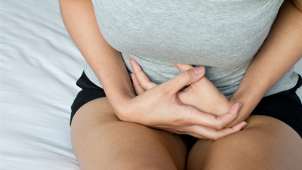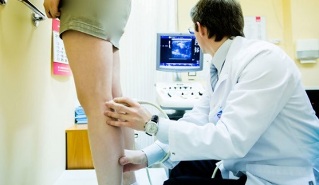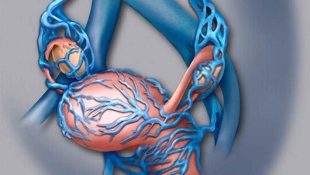
Both men and women are susceptible to varicose veins, but the weaker sex often suffers from the consequences of this disease. Most often, associations with the mention of varicose veins occur with swelling of the veins of the legs below the knee, but there are varicose veins of the small pelvis in women. This is a fairly common disease, which all women in childbearing are at risk of contracting.
Most often varicose veins of the small pelvis occur in women who perform heavy physical labor or during pregnancy. This is due to increased stress on the female body causing increased venous pressure, which causes varicose veins in the hip.
Sudden pain in the lower abdomen is the first symptom of varicose veins in the small pelvis.
Varicose veins of internal organs are especially dangerous for pregnant women and are one of the main reasons for prescribing a cesarean section. Doctors explain this by the fact that natural childbirth can cause bleeding, and the life of both mother and child will be in danger. The incidence of this disease during pregnancy is due to the fact that the enlarged uterus is compressed and interferes with normal blood circulation. The increase in hormone levels is also a contributing factor to the appearance of varicose veins in the small pelvis.
Due to changes in hormone levels in mature women, the disease may begin to develop during puberty. The situation is complicated by the fact that it is quite difficult to detect varicose veins of the pelvic veins, since the disease that has arisen during this period of life is rarely manifested with obvious symptoms. An indirect reason for consulting a specialist may be increased discharge from the organs of the female reproductive system.
Quite often, varicose veins of the small pelvis in women occur during sedentary work in the office. This is caused by the loss of plasticity of the venous walls, due to the poor mobility of a person. Men are also susceptible to this disease, but much less often than women.
The most obvious symptom of varicose veins in the small pelvis can be more frequent pain in the lower abdomen, especially when standing, when the body is upright. Often times the pain can be caused by intercourse or other severe stress on the body. In addition, from the small pelvis, varicose veins can spread to the perineum and gluteal region.
Experts call internal varicose veins of the small pelvis a complex disease. This is due to the difficulties in diagnosis, as there are not so many symptoms of the onset of the disease and they do not manifest themselves clearly. The speed of detection of varicose veins gives hope for a complete recovery. There is also a high risk of misdiagnosis at an early stage in the development of the disease.
The main causes of the disease

Poor heritability may be the problem.
Dysplasia of connective tissues is considered a harbinger of their pathology, which causes varicose veins of the pelvic vessels. These problems are often caused by poor heredity, but people whose lives are associated with the following factors can also suffer from varicose veins:
- Office work or other sedentary occupation;
- Intense physical activity, if the body is not prepared for it in advance;
- Irregular sexual activity;
- Elevated estrogen hormone;
- Gynecological diseases in women, frequent inflammation;
- Tumors located near internal organs.
The studies carried out prove the link with the use of contraceptives and other hormonal drugs with the appearance of varicose veins in the small pelvis.
The coverage of this disease in pregnant women requires special attention. Unfortunately, up to 30% of all cases, diseases are observed in women during this period. Doctors tend to believe that pregnancy can give impetus to the emergence of connective tissue dysplasia in a woman's body, which leads to varicose veins.
Varicose veins of the small pelvis in women occur due to an increase in the number of female hormones in the body, their effect has a similar effect on the body with the use of contraceptives. This is aggravated by the fact that during the development of the fetus, pressure is exerted on the internal veins of the pelvis, resulting in increased compression. Additional pathways for the outflow of blood are formed, which after childbirth are no longer needed, and a recovery procedure is required to remove them.
In the antenatal clinic for those who register there is a risk group, which includes women with a predisposition to inflammation of the reproductive organs. Pregnant women with high estrogen levels also require special attention.
Symptoms of the disease

The main symptoms of varicose veins of the pelvic organs include more frequent pain in the lower abdomen, as well as a heavy discharge of mucus from the genitals. But there may be other reasons for these signs, which is why it is so difficult to diagnose these varicose veins of the small pelvis in the early stages.
Indirect signs include detection of swollen veins in the buttocks and perineum. In some patients, pain in the lower abdomen increases during the first few days of the menstrual cycle.
Some of the main symptoms indicating pelvic varicose veins in women include:
- Pain before menstruation is stronger than usual;
- Menstrual irregularities;
- Improvement of sensitive sensations in the perineal region;
- Pain radiating from the lower abdomen to the lower back;
- Increased vaginal sensitivity;
- Frequent urination;
- Severity of the lumbar spine on standing or prolonged sitting.
Depending on the stage of development of pelvic varicose veins and the individual characteristics of each woman, several symptoms may be observed at once, or each of them individually. In any case, if any of the listed signs are detected, you need to go to the gynecologist's office.
Diagnostic methods
There are several methods for detecting and diagnosing varicose veins of the pelvic organs, but Doppler ultrasound is considered the main one. When using this procedure, it is possible with ultrasound to identify the contours of the veins and project them onto the screen of the device or take a picture. The image allows you to detect all places of deformation of the veins with reduced blood flow.

For a clearer picture, doctors use venography in the diagnosis. The uterine veins are filled with a substance that gives contrast during fluoroscopy.
The difficulty in diagnosis, associated with mild symptoms, is the absence of a specific site of localization, varicose veins of the small pelvis.
When diagnosed by a doctor, varicose veins can be mistaken for a common inflammatory process, the likelihood of such an error is especially high in the early stages.
Important!If the gynecologist diagnosed inflammation and prescribed treatment, but this does not help cope with the symptoms, it should be understood that such an effect is not normal and it is imperative to doa second visit to the specialist.
With confidence, you can make a correct diagnosis using the following methods:
- Doppler ultrasound;
- Phlebography - quite accurately diagnoses varicose veins of the small pelvis;
- Ultrasound of the venous system - in different situations, a vaginal examination or transabdominal scan is used;
- Laparoscopy - with this method you can also identify varicose formations in the ovaries;
- Selective ovarycography - this diagnostic method is most likely to find varicose veins in the small pelvis. For this, a contrast liquid is injected into the veins of the thighs and the subclavian region.
If the diagnosis does not provide accurate results, the patient may be referred for further examination. A blood test is prescribed.
Classification of degree of illness
Depending on the stage and severity of pelvic varicose veins, it can be divided into three categories. An important parameter in this regard is also the localization of the localization of varicose veins.
- Varicose veins of the small pelvis in the first stage swell the veins up to 5 mm due to the appearance of a small number of deformed areas;
- In the second stage, the veins are 6-10 mm in diameter, and loose plexus ectasia occurs in the ovary;
- The last degree is the most dangerous, the venous swelling of the patient exceeds 10 mm in volume. The third degree of damage is characterized by a parametric localization of the main type.
After successful diagnosis and determination of the stage of the disease, appropriate treatment of varicose veins is prescribed.
Conservative treatment methods

It is best to contact the appropriate specialists after making an accurate diagnosis. Diseases associated with varicose veins are treated by a phlebologist. You can only be referred to it after the diagnosis made by a gynecologist and the expansion of the pelvic veins in men confirmed by a urologist.
The main tasks that set the physician on the path to patient recovery are:
- Restore damaged venous walls and restore them to their usual tone;
- Prevention of the formation of subsequent stagnation of blood in the veins of the small pelvis;
- Improved condition of venous tissue.
To solve the defined tasks, complex therapy is used, which includes a special diet, rehabilitation exercises, drugs for the treatment of varicose veins and the use of special shaping underwear.
Therapeutic phase of treatment
The main goal of treatment for small pelvic varicose veins is to restore blood circulation and normalize the tone of elastic tissues. No less important are the stages of eliminating the unpleasant symptoms of the disease and increasing blood circulation in the veins.
Preparations for varicose veins should only be prescribed by a phlebologist. There are two groups of drugs prescribed for this disease. The first (venotamic drugs) - improves the tone of vein tissue, and the second (angiaggregants) - prevents the formation of new blood clots.
In case of exacerbation of varicose veins in the small pelvis, ongoing medication is an important part of therapy. The main role in treatment is given to venotonic drugs, which improve vascular tone. To prevent recurrence of the disease, these drugs are prescribed prophylactically.
Preparations for the treatment of varicose veins of the small pelvis can only be prescribed by a doctor, self-medication is unacceptable!

In general, medicines for varicose veins help:
- Stop the backflow of blood;
- Normalization of venous tone;
- Helps in the blood supply to tissues;
- Reduce the discomfort caused by symptoms of the disease.
It should be remembered that the use of drugs should be combined with special exercises and a prescribed diet.
Traditional medicine
For the treatment of varicose veins of the small pelvis, they often resort to traditional methods, among which the main remedies are herbal infusions that restore the normal tone of the veins. The most popular decoctions are horse chestnut, chaga and dandelion roots.
Hirudotherapy has proven itself to the population: leeches should be applied in the region of the sacrum and coccyx.
Important to know!It is impossible to let the varicose veins revealed in the small pelvis drift or to rely only on the means of traditional medicine. This rather dangerous disease should be treated comprehensively, with the compulsory intake of drugs, and the use of infusions and decoctions can only be an additional means.
Preventive gymnastics
There are several physical training techniques for restoring tissue tone.
- When raising and lowering on the toes, the exercise is done in a standing position, the number of repetitions is at least 30, the toes and heels are parallel;
- Same thing, just spread the socks apart and line up the heels 30 times;
- Repeat the toe lift, spreading the heels as far apart as possible and bringing the toes together;
- Pelvic varicose veins can be treated with breathing exercises, slowing down by imagining how all the abdominal muscles are involved;
- While lying down, lift the pelvis, supporting it with your hands, and doing a "cycling" movement, for those who find this exercise difficult, you can replace them with a "birch" or alternate them.

Physiotherapy works well if the veins in the small pelvis are dilated, besides, it is convenient to do it anywhere. The main condition for success will be the regularity of performing special exercises, but in no case should you overwork yourself during classes.
It is just as important to follow a healthy lifestyle if you have been diagnosed with dilation of the veins. During physical labor, you need to take regular breaks, and if it is associated with a long stay in a static position, you need to periodically take a break, warm up and walk.
A good solution would be to use a contrast shower, varicose veins cause unpleasant sensations in the perineal area, so it will not be superfluous to direct the water jet towards this area.
Good nutrition
It is important to develop a diet so that there are no problems with bowel movements, especially constipation. With these, venous expansion can be aggravated by an increase in internal pressure during bowel movements. It is also best to avoid eating foods that are too spicy and fatty, as they affect the formation of blood clots.
The nutritional correction of pelvic varicose veins involves the exclusion of foods rich in saturated fat, from any alcoholic drink. Preference in the diet should be given in favor of foods rich in fiber (vegetables and fruits, cereals), healthy fats (vegetable oils).
Having learned from the doctor how to treat varicose veins of the small pelvis and what dietary restrictions to apply, you need to take care of the general condition of the body, for this it is better to stop bad habits (smoking and alcohol)during rehabilitation.
Possible complications

Varicose veins of the pelvic organs can lead to serious complications for the female body, especially in the later stages of the disease. Sometimes the inflammation spreads to nearby organs, the bleeding from the uterus looks more frightening.
For better protection, you must understand the danger of pelvic varicose veins. Frequent bleeding in the uterus can contribute to the formation of thrombosis and develop into a widespread inflammatory process.
Forecast
Varicose veins of the small pelvis in women can contribute to the development of serious consequences, but most often they occur in advanced stages, due to the late detection of the disease. Therefore, you should pay attention to pain with pelvic varicose veins, as they are the most obvious symptom, signaling the need to go to the doctor.























